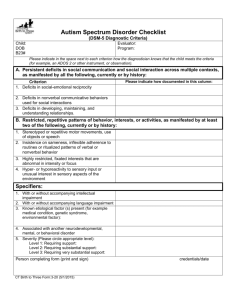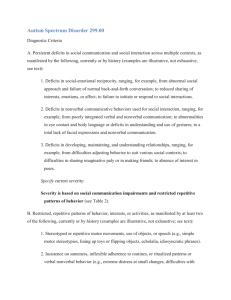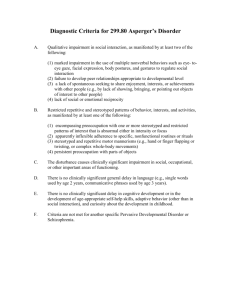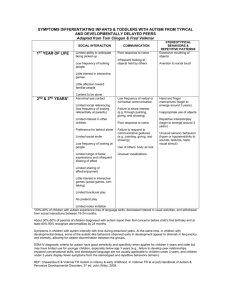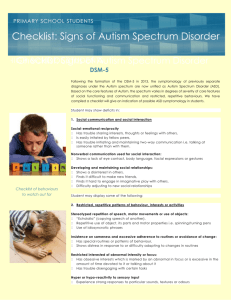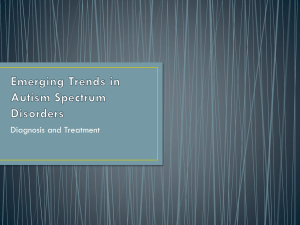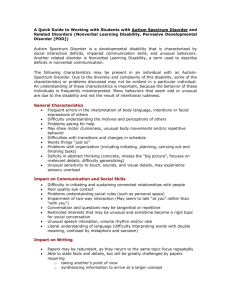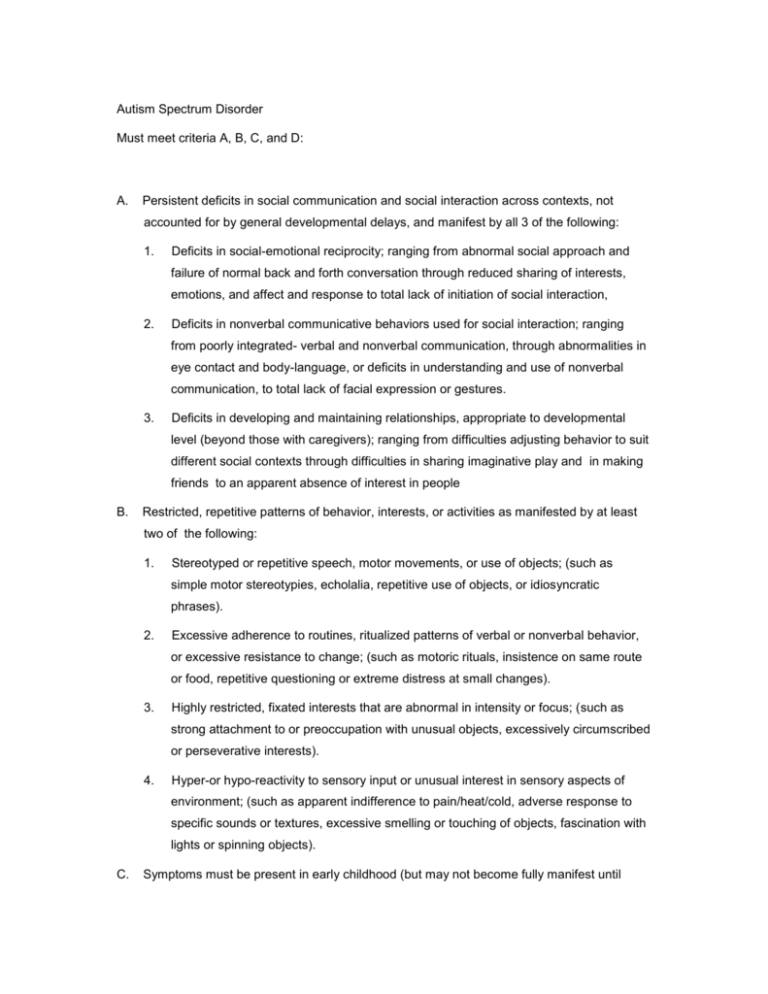
Autism Spectrum Disorder
Must meet criteria A, B, C, and D:
A.
Persistent deficits in social communication and social interaction across contexts, not
accounted for by general developmental delays, and manifest by all 3 of the following:
1.
Deficits in social-emotional reciprocity; ranging from abnormal social approach and
failure of normal back and forth conversation through reduced sharing of interests,
emotions, and affect and response to total lack of initiation of social interaction,
2.
Deficits in nonverbal communicative behaviors used for social interaction; ranging
from poorly integrated- verbal and nonverbal communication, through abnormalities in
eye contact and body-language, or deficits in understanding and use of nonverbal
communication, to total lack of facial expression or gestures.
3.
Deficits in developing and maintaining relationships, appropriate to developmental
level (beyond those with caregivers); ranging from difficulties adjusting behavior to suit
different social contexts through difficulties in sharing imaginative play and in making
friends to an apparent absence of interest in people
B.
Restricted, repetitive patterns of behavior, interests, or activities as manifested by at least
two of the following:
1.
Stereotyped or repetitive speech, motor movements, or use of objects; (such as
simple motor stereotypies, echolalia, repetitive use of objects, or idiosyncratic
phrases).
2.
Excessive adherence to routines, ritualized patterns of verbal or nonverbal behavior,
or excessive resistance to change; (such as motoric rituals, insistence on same route
or food, repetitive questioning or extreme distress at small changes).
3.
Highly restricted, fixated interests that are abnormal in intensity or focus; (such as
strong attachment to or preoccupation with unusual objects, excessively circumscribed
or perseverative interests).
4.
Hyper-or hypo-reactivity to sensory input or unusual interest in sensory aspects of
environment; (such as apparent indifference to pain/heat/cold, adverse response to
specific sounds or textures, excessive smelling or touching of objects, fascination with
lights or spinning objects).
C.
Symptoms must be present in early childhood (but may not become fully manifest until
social demands exceed limited capacities)
D.
Symptoms together limit and impair everyday functioning.
New name for category, autism spectrum disorder, which includes autistic disorder (autism),
Asperger’s disorder, childhood disintegrative disorder, and pervasive developmental disorder
not otherwise specified.
Differentiation of autism spectrum disorder from typical development and other
"nonspectrum" disorders is done reliably and with validity; while distinctions among
disorders have been found to be inconsistent over time, variable across sites and often
associated with severity, language level or intelligence rather than features of the
disorder.
Because autism is defined by a common set of behaviors, it is best represented as a
single diagnostic category that is adapted to the individual’s clinical presentation by
inclusion of clinical specifiers (e.g., severity, verbal abilities and others) and associated
features (e.g., known genetic disorders, epilepsy, intellectual disability and others.) A
single spectrum disorder is a better reflection of the state of knowledge about pathology
and clinical presentation; previously, the criteria were equivalent to trying to “cleave
meatloaf at the joints”.
Three domains become two:
1)
Social/communication deficits
2)
Fixated interests and repetitive behaviors
Deficits in communication and social behaviors are inseparable and more accurately
considered as a single set of symptoms with contextual and environmental specificities
Delays in language are not unique nor universal in ASD and are more accurately
considered as a factor that influences the clinical symptoms of ASD, rather than defining
the ASD diagnosis
Requiring both criteria to be completely fulfilled improves specificity of diagnosis without
impairing sensitivity
Providing examples for subdomains for a range of chronological ages and language
levels increases sensitivity across severity levels from mild to more severe, while
maintaining specificity with just two domains
Decision based on literature review, expert consultations, and workgroup discussions;
confirmed by the results of secondary analyses of data from CPEA and STAART,
University of Michigan, Simons Simplex Collection databases
Several social/communication criteria were merged and streamlined to clarify diagnostic
requirements.
In DSM-IV, multiple criteria assess same symptom and therefore carry excessive weight
in making diagnosis
Merging social and communication domains requires new approach to criteria
Secondary data analyses were conducted on social/communication symptoms to
determine most sensitive and specific clusters of symptoms and criteria descriptions for
a range of ages and language levels
Requiring two symptom manifestations for repetitive behavior and fixated interests improves
specificity of the criterion without significant decrements in sensitivity. The necessity for multiple
sources of information including skilled clinical observation and reports from
parents/caregivers/teachers is highlighted by the need to meet a higher proportion of criteria.
The presence, via clinical observation and caregiver report, of a history of fixated interests,
routines or rituals and repetitive behaviors considerably increases the stability of autism
spectrum diagnoses over time and the differentiation between ASD and other disorders.
Reorganization of subdomains increases clarity and continues to provide adequate sensitivity
while improving specificity through provision of examples from different age ranges and
language levels.
Unusual sensory behaviors are explicitly included within a sudomain of stereotyped motor and
verbal behaviors, expanding the specfication of different behaviors that can be coded within this
domain, with examples particularly relevant for younger children
Autism spectrum disorder is a neurodevelopmental disorder and must be present from infancy
or early childhood, but may not be detected until later because of minimal social demands and
support from parents or caregivers in early years.
Revised January 26, 2011
Severity Level for ASD
Social Communication
Restricted interests & repetitive
behaviors
Level 3
‘Requiring very substantial support’
Level 2
‘Requiring substantial support’
Level 1
‘Requiring support’
Severe deficits in verbal and nonverbal
social communication skills cause
severe impairments in functioning; very
limited initiation of social interactions
and minimal response to social
overtures from others.
Preoccupations, fixated rituals and/or
repetitive behaviors markedly interfere
with functioning in all spheres. Marked
distress when rituals or routines are
interrupted; very difficult to redirect from
fixated interest or returns to it quickly.
Marked deficits in verbal and nonverbal
social communication skills; social
impairments apparent even with
supports in place; limited initiation of
social interactions and reduced or
abnormal response to social overtures
from others.
RRBs and/or preoccupations or fixated
interests appear frequently enough to
be obvious to the casual observer and
interfere with functioning in a variety of
contexts. Distress or frustration is
apparent when RRB’s are interrupted;
difficult to redirect from fixated interest.
Without supports in place, deficits in
social communication cause noticeable
impairments. Has difficulty initiating
social interactions and demonstrates
clear examples of atypical or
unsuccessful responses to social
overtures of others. May appear to
have decreased interest in social
interactions.
Rituals and repetitive behaviors (RRB’s)
cause significant interference with
functioning in one or more contexts.
Resists attempts by others to interrupt
RRB’s or to be redirected from fixated
interest.
Autistic Disorder
A. A total of six (or more) items from (1), (2), and (3), with at least two from (1), and one each
from (2) and (3):
(1) qualitative impairment in social interaction, as manifested by at least two of the
following:
(a) marked impairment in the use of multiple nonverbal behaviors such as eye-to-eye
gaze, facial expression, body postures, and gestures to regulate social interaction
(b) failure to develop peer relationships appropriate to developmental level
(c) a lack of spontaneous seeking to share enjoyment, interests, or achievements with
other people (e.g., by a lack of showing, bringing, or pointing out objects of interest)
(d) lack of social or emotional reciprocity
(2) qualitative impairments in communication as manifested by at least one of the
following:
(a) delay in, or total lack of, the development of spoken language (not accompanied by
an attempt to compensate through alternative modes of communication such as
gesture or mime)
(b) in individuals with adequate speech, marked impairment in the ability to initiate or
sustain a conversation with others
(c) stereotyped and repetitive use of language or idiosyncratic language
(d) lack of varied, spontaneous make-believe play or social imitative play appropriate to
developmental level
(3) restricted repetitive and stereotyped patterns of behavior, interests, and activities, as
manifested by at least one of the following:
(a) encompassing preoccupation with one or more stereotyped and restricted patterns
of interest that is abnormal either in intensity or focus
(b) apparently inflexible adherence to specific, nonfunctional routines or rituals
(c) stereotyped and repetitive motor mannerisms (e.g., hand or finger flapping or
twisting, or complex whole body movements)
(d) persistent preoccupation with parts of objects
B. Delays or abnormal functioning in at least one of the following areas, with onset prior to age 3
years: (1) social interaction, (2) language as used in social communication, or (3) symbolic or
imaginative play.
C. The disturbance is not better accounted for by Rett’s Disorder or Childhood Disintegrative
Disorder.
American Psychiatric Association
Representing 36,000 physician leaders in mental health.
© 2012 American Psychiatric Association. All Rights Reserved.
Use of all Materials on this Website is subject to Terms and Conditions
of Use.

